Sudden neutropenia and emesis in an SGA infant
A 24-year-old G2P1001 African American female at 38.2 weeks of gestation was induced for labor for a fetus with prenatally diagnosed intrauterine growth restriction (IUGR). She subsequently delivered via normal spontaneous delivery. The infant initially latched well at the breast, was normoglycemic and normothermic, but shortly after birth had had a significant episode of blood-tinged emesis (not deemed to be swallowed maternal blood) and was transferred to the transitional nursery for further evaluation.
Figure 1
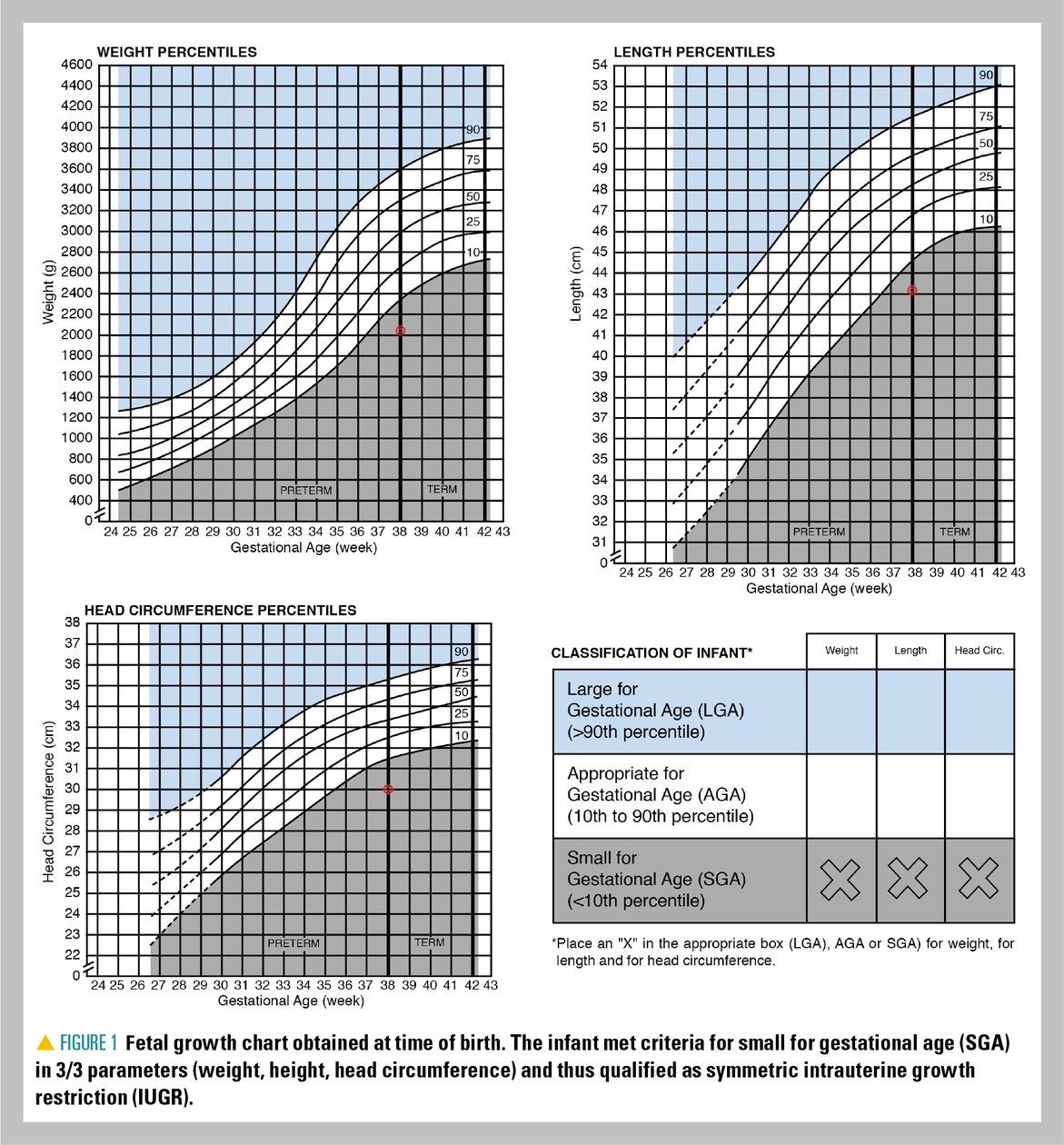
Figure 2
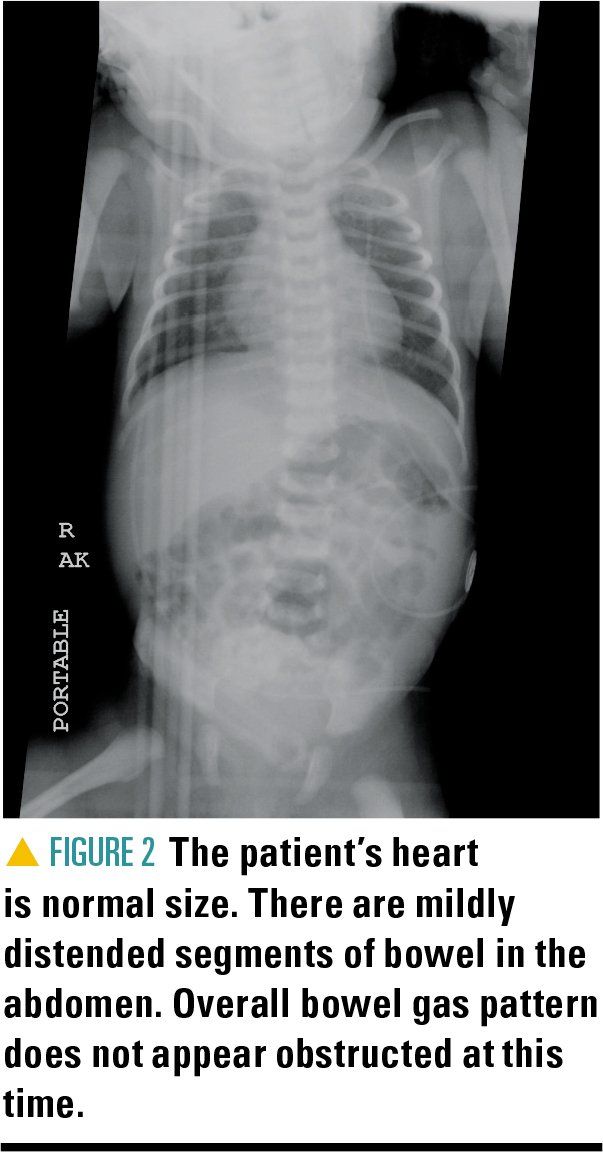
Table 1
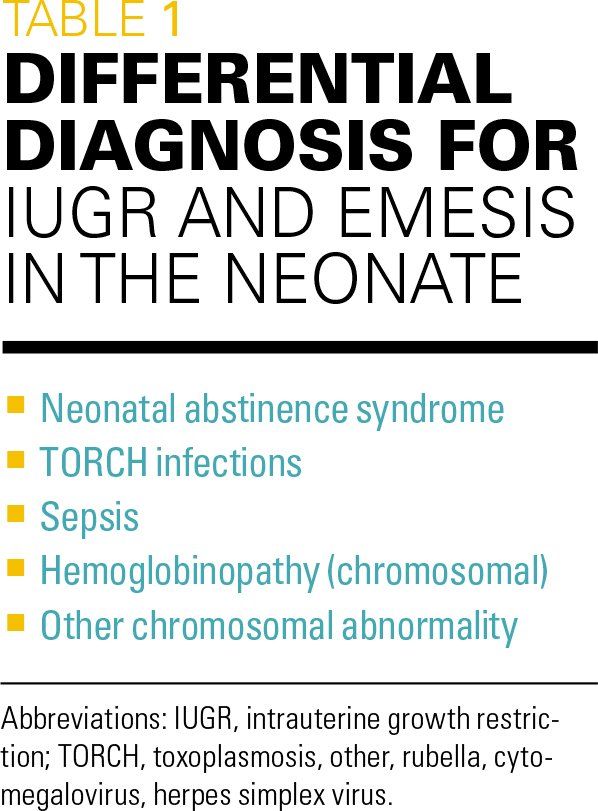
Table 2
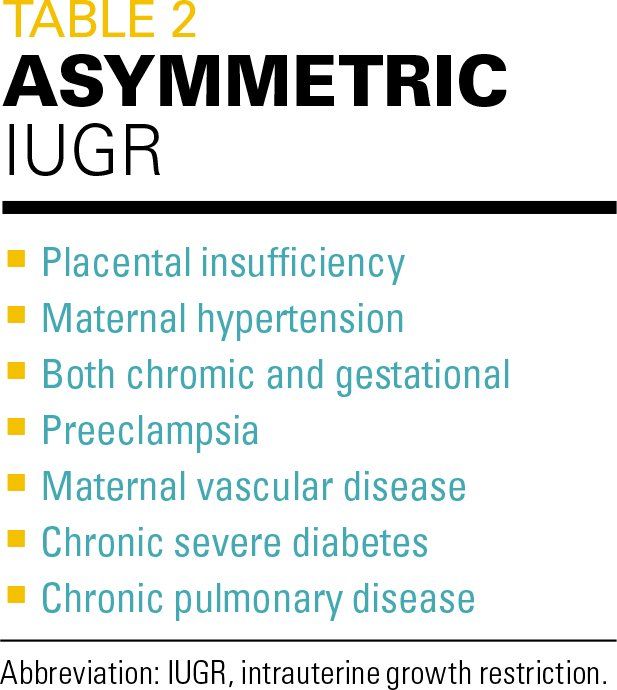
Table 3
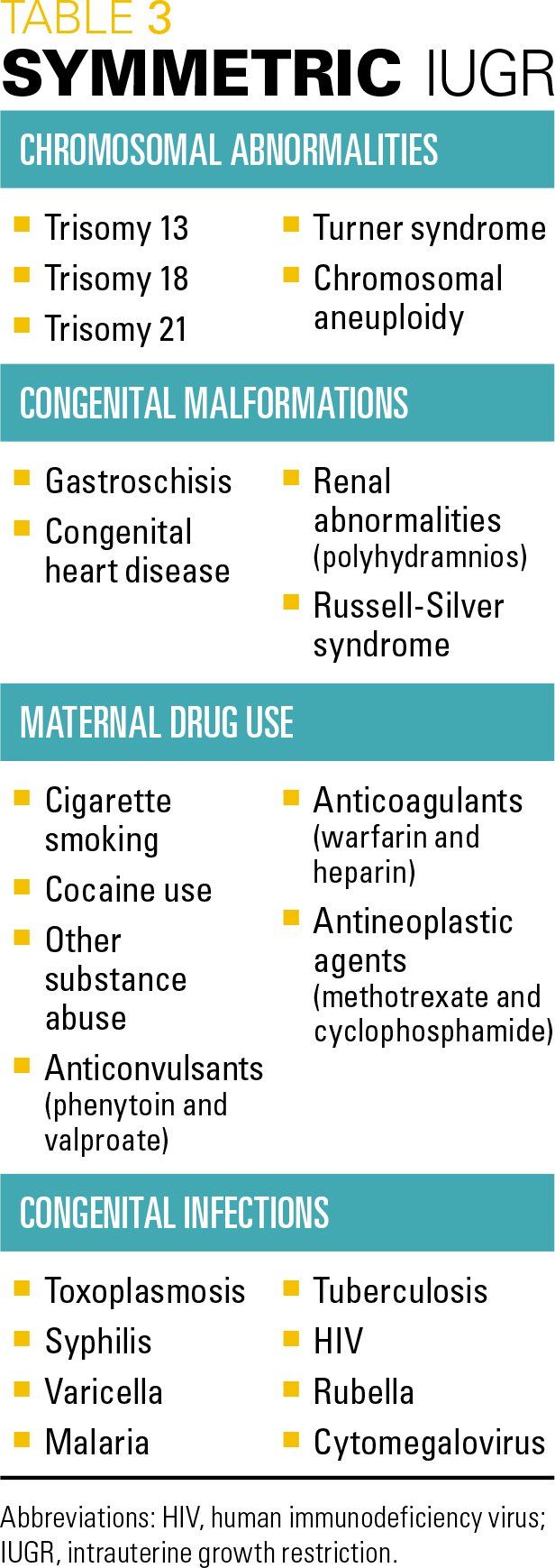
Table 4
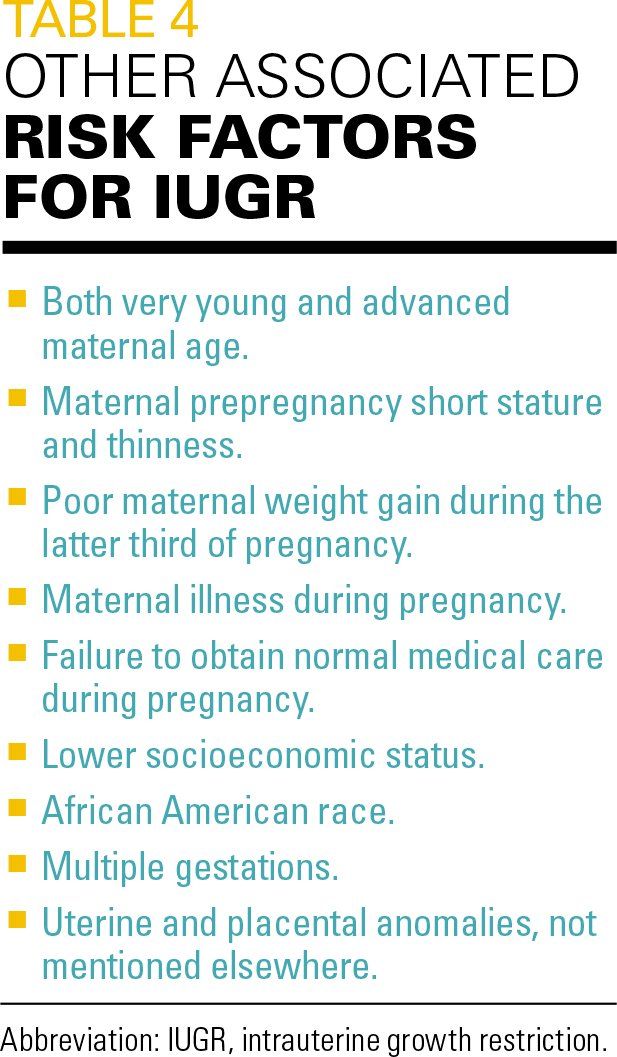
The case
A 24-year-old G2P1001 African American female at 38.2 weeks of gestation was induced for labor for a fetus with prenatally diagnosed intrauterine growth restriction (IUGR). She subsequently delivered via normal spontaneous delivery complicated by presence of heavily meconium-stained amniotic fluid with no signs of meconium aspiration. The infant cried immediately at birth with Apgar scores of 9/9, with deductions for color at 1 and 5 minutes.
On initial examination, the infant was notably small for gestational age (SGA) and below the 10th percentile (-3 SD) for weight (2047g), height (43.2 cm), and head circumference (30 cm). See Figure 1. No dysmorphic features were noted, and her newborn physical examination was otherwise normal. She was full term based on her Dubowitz assessment (Dubowitz score = 38).
Maternal and familial history
Maternal prenatal labs were all within normal limits with no tobacco, alcohol, or illicit substance use reported during the course of her pregnancy. The mother’s past medical history was significant for a learning disorder and a rare hemoglobinopathy called hemoglobin Willamette, a variant of the beta-globin gene that affects fewer than 20 individuals worldwide. She was not anemic, had no other chronic diseases such as hypertension, and was well nourished with adequate weight gain during pregnancy. The maternal blood type was A-positive; AB screen was negative; Group B strep (GBS) was negative; rubella immune. The remainder of prenatal labs were found to be negative/within normal limits.
The mother has another daughter (aged 5 years; gestational age at birth, 38.3 weeks) also found to have symmetric IUGR/SGA at birth with autism and developmental delay. The maternal grandmother of the infant died at age 31 years from kidney disease, and the siblings of the infant’s maternal great-grandmother also had passed away from kidney-related complications. The father of the infant is a 22-year-old African American male with a learning disability and is also the father of the mother’s first child. He has hemoglobin AA. Of note, this mother reported that she also was “very small” at birth.
Hospital course
Although rooming with the mother is the optimal environment for infants, those who are SGA need to be monitored closely to ensure adequate feeding, absence of hypoglycemia, and ability to maintain thermal stability. This infant initially latched well at the breast, was normoglycemic and normothermic, but shortly after birth had had a significant episode of blood-tinged emesis (not deemed to be swallowed maternal blood) and was transferred to the transitional nursery for further evaluation.
Due to persistence of emesis and subsequent hypothermia, a sepsis screen was sent and the infant was started on empiric intravenous (IV) antibiotics of ampicillin and gentamicin. After acute obstruction was ruled out, the infant was preferentially fed with breast milk, and when that was not available was trialed with 3 different formulas for some ongoing spitting and a concern for formula intolerance. The infant’s symptoms improved on ProSobee (soy formula) and she stooled normally with benign abdominal examination.
After 48 hours, the blood culture on the infant was negative and the clinical symptoms had improved, so the antibiotics were discontinued. She also required thermal support in an incubator and weaning protocol was initiated based on monitoring of her ongoing weight gain and ability to maintain normothermia. Because of her mother’s history of a rare hemoglobin variant, close monitoring of her complete blood count (CBC) was initiated. The results revealed the beginnings of a sudden neutropenia on day of life 9-absolute neutrophil count (ANC) of 1472-for which she received another course of antibiotics and was placed on reverse isolation. Repeat culture results remained negative but despite initial improvement the neutropenia returned on day of life 16.
Hematology consult revealed normal peripheral smears and no definitive diagnosis for the neutropenia. As part of the obstetric evaluation of the prenatally diagnosed growth restriction and complex family history, Genetics consultation with the mother had been ongoing. Results of the maternal genetic analysis were obtained during this infant’s hospitalization and this ultimately enabled the final diagnosis on this infant providing a probable cause for her constellation of clinical findings.
Laboratory testing and imaging
At the time of her initial presentation, blood was also sent for a CBC, comprehensive metabolic panel (CMP), and blood culture, and the infant was scheduled for an abdominal x-ray given her recurrent bouts of emesis. Her point-of-care glucose testing for 24 hours remained stable and was subsequently discontinued. Her abdominal radiograph (Figure 2) revealed a normal-sized heart with mildly distended segments of bowel in the abdomen and an overall gas pattern that did not appear to be obstructed. Her CMP levels were: sodium, 134-137; potassium, 4.5-5.9; chloride, 109; carbon dioxide (CO2), 17-20; creatinine, 0.22-0.32; and calcium, 9.9-11. Additional labs revealed a neutropenia that presented over the course of her hospital stay. A peripheral blood smear was examined and found to be within normal limits. Final blood cultures sent on 2 separate occasions showed no growth and urine cytomegalovirus (CMV) culture was negative. Pursuant to standard nursery protocol, a newborn metabolic screen was sent and came back positive for a hemoglobinopathy.
Differential diagnosis
Given the host of symptoms and complex history that the patient presented, there were multiple possible differentials (Table 1).
Exposure to drugs (prescribed or illicit) in utero can result in neonatal abstinence syndrome (NAS) due to withdrawal from illicit substances used prenatally or withdrawal due to discontinuation of prescription medications (typically narcotic therapy). Signs and symptoms of this withdrawal can include a high-pitched cry, emesis, tremors, fever and/or sweating, poor feeding, or diarrhea. This diagnosis was ruled out because of the combination of a negative urine toxicology screen (for both mother and baby) and noncontributory history; ie, the patient’s mother denied any tobacco, alcohol, illicit drugs, or prescription drug use during this pregnancy.
The second most likely differential was a possible TORCH infection: infection from toxoplasmosis, other (syphilis, parvovirus, varicella zoster virus [VZV], human immunodeficiency virus [HIV], Zika virus), rubella, cytomegalovirus (CMV), or herpes simplex virus (HSV). Of these, infection with CMV, rubella, or VZV can result in IUGR. However, the patient’s mother was rubella immune, so congenital rubella was not suspected. Fewer than 2% of women who contract VZV during their first 20 weeks of pregnancy give birth to an infant with congenital varicella syndrome. It is also probable, given the mother’s age, that she obtained the VZV vaccination as a child or contracted it prior to becoming pregnant. Furthermore, cutaneous scars in a dermatomal pattern can be seen at birth or as a rash within the first 10 days of life (not observed on this patient). Thus, VZV was not high on the list of suspected TORCH infections. If the IUGR was caused by a TORCH infection, the most likely one would have been CMV, but the viral culture came back negative.
Lower on the differentials were sepsis and a possible inherited hemoglobinopathy. There are a host of hematologic disorders associated with diminished fetal growth. Given that this patient’s mother has hemoglobin Willamette (β51Pro→Arg)-an extremely rare hereditary hemoglobinopathy caused by structural defects as a result of a mutation that substitutes proline with arginine at the 51st position in the β chain-clinicians suspected it as a possible cause for the host of symptoms the patient displayed. A review of the research showed that it does not produce clinical evidences of significant hematologic or chemical abnormalities, except for the presence of target red blood cells (RBCs). Most patients are asymptomatic, but some can present with hemolytic anemia due to its high reticulocyte index and RBCs. The mother was not diagnosed with anemia during pregnancy, and the patient’s peripheral blood smear displayed normochromic and normocytic RBCs with no evidence of hemolysis or abnormal cells, particularly target RBCs, leaving a possible other chromosomal abnormality as the most likely cause of the patient’s symptoms.
The infant had symmetrical IUGR, recurrent episodes of emesis, and unexplained neutropenia in the context of an extremely complex family genetic history. Intrauterine growth restriction is defined as a fetus with an estimated weight below the 10th percentile for gestational age.1 Overall, IUGR affects about 5% of the general obstetric population. However, the incidence varies depending on survey demographics (eg, geographic location, standard of growth curve used).2 It is most often idiopathic, but it can be grouped based on etiology: symmetric versus asymmetric.1,3
Asymmetric growth restriction (Table 2) implies a fetus who is undernourished and is directing most of its energy to maintaining growth of vital organs at the expense of fat deposition. These infants will have preservation of limb length and head circumference but be of low birth weight. This type of growth restriction is usually the result of placental insufficiency.2
Symmetric IUGR (Table 3), also called early-onset IUGR, implies a fetus whose entire body is proportionally small. The period of insult for symmetrical IUGR is generally earlier in gestation (first trimester) when compared with asymmetrical IUGR (third trimester), and the prognosis is poorer.4 Symmetric IUGR encompasses a minority of cases (30%) and is due to intrinsic factors such as chromosomal anomalies and aneuploidy, congenital infections in early pregnancy, congenital malformations, and multiple gestations.5
Common chromosomal abnormalities of IUGR are considered fetal risk factors, including Trisomy 13, Trisomy 18, Trisomy 21, and Turner syndrome.1,3 Other fetal risk factors for symmetric IUGR include congenital malformations such as gastroschisis, congenital heart disease, and renal abnormalities. Russell-Silver syndrome manifests as IUGR with postnatal growth deficiency, limb and facial asymmetry, clinodactyly, and episodes of hypoglycemia.6
Maternal risk factors for symmetric IUGR include prior IUGR, as is the case in this infant. Certain medications such as the anticonvulsants phenytoin and valproic acid, anticoagulants warfarin and heparin, and antineoplastic agents such as methotrexate and cyclophosphamide are known to cause growth restriction.6,7 Maternal infection with toxoplasmosis, syphilis, varicella, malaria, tuberculosis, HIV, rubella, CMV, and Zika virus can be transmitted across the placenta and lead to symmetric IUGR depending on when the mother acquires the infection.
There are also other risk factors that have been associated with IUGR.2,4 These are listed in Table 4.
Other than symmetric IUGR, this infant did not present with any other features typical of intrauterine infections or known genetic syndromes. However, a genetic etiology was highest on the list of differential diagnosis due to the complex history. The mother consented to genetic testing of this infant, and the patient was subsequently found to have the chromosomal deletion Xp11.4p11.23-the same Xp deletion shared by the infant’s mother and sister. A detailed review of open-source genetic databases (Online Mendelian Inheritance in Man: OMIM, www.ncbi.nlm.nih.gov/omim; and Decipher, https://decipher.sanger.ac.uk/) found several syndromes linked to Xp deletion within or adjacent to the Xp deletion found in the infant, including ornithine transcarbamylase (OTC) deficiency, Kabuki syndrome, Norrie disease, and Wiskott-Aldrich syndrome.8-10
The database also identified one infant in whom the clinical presentation of the Xp deletion also included neutropenia (via de novo mutation [DNM]).8 The clinicians were unable to identify a link between persistent neutropenia and this patient’s Xp11.4p11.23 deletion in the literature. Of additional interest were the results of her newborn metabolic screen that were positive for an unspecific hemoglobinopathy, indicating that she may be a carrier of hemoglobin Willamette, which typically does not produce significant chemical and hematological abnormalities or anemia.
Patient outcome
The infant needed a final hemoglobin electrophoresis, so she was referred to the outpatient Genetics and Hematology specialists at the local children’s hospital. Unfortunately, she was lost to follow-up.
Summary
Pediatricians working in the newborn setting are often the first to detect potential genetic insults. Because of the increased morbidity and mortality of infants with symmetrical IUGR, a thorough physical examination and a detailed genetic family history should be obtained. Of particular note, potential cardiac, renal, and other life-threatening complications need to be ruled out early. In this case, despite both the parents having learning disabilities, they were able to provide a comprehensive history that prompted clinicians to communicate with their prenatal genetic counselor and lead to the final and unique diagnosis.
In settings where access to genetic specialists is limited, the National Institutes of Health’s OMIM database can be an extremely helpful tool from both clinical and diagnostic standpoints.8 Although difficult, communicating genetic diagnoses with families of newborns can be done compassionately and lead to early intervention and coordination of much-needed outpatient services for these infants as they grow.
References:
1. Anderson MS, Hay WW. Intrauterine growth restriction and the small-for-gestational-age infant. In: Avery’s Neonatology: Pathophysiology and Management of the Newborn. 5th ed. Avery GB, Fletcher MA, MacDonald MG (eds), Philadelphia, PA: Lippincott Williams and Wilkins; 1999:411.
2. Peleg D, Kennedy CM, Hunter SK. Intrauterine growth restriction: identification and management. Am Fam Physician. 1998; 58(2):453-460, 466-467.
3. Beune IM, Bloomfield FH, Ganzevoort W, et al. Consensus-based definition of growth restriction in the newborn. J Pediatr. 2018;196:71.e1-76.e1.
4. Sharma D, Shastri S, Sharma P. Intrauterine growth restriction: antenatal and postnatal aspects. Clin Med Insights Pediatr. 2016;10:67-83.
5. Peng R, Yang J, Xie HN, Lin MF, Zheng J. Chromosomal and subchromosomal anomalies associated to small for gestational age fetuses with no additional structural anomalies. Prenat Diagn. 2017;37(12):1219-1224. Erratum in: Prenat Diagn. 2018;38(3):224.
6. Abu-Amero S, Monk D, Frost J, Preece M, Stanier P, Moore GE. The genetic aetiology of Silver-Russell syndrome. J Med Genet. 2008;45(4):193-199.
7. Longo S, Borghesi A, Tzialla C, Stronati M. IUGR and infections. Early Hum Dev. 2014;90 suppl 1:S42-S44.
8. Johns Hopkins University. Online Mendelian Inheritance in Man (OMIM). Available at: https://www.omim.org/. Updated July 17, 2019. Accessed July 18, 2019.
9. Decipher. Database of Chromosomal Imbalance and Phenotype in Humans Using Ensembl Resources. Available at: https://decipher.sanger.ac.uk/. Accessed July 18, 2019.
10. Firth HV, Richards SM, Bevan AP, et al. DECIPHER: Database of Chromosomal Imbalance and Phenotype in Humans Using Ensembl Resources. Am J Hum Genet. 2009;84(4)524-533.
Newsletter
Access practical, evidence-based guidance to support better care for our youngest patients. Join our email list for the latest clinical updates.